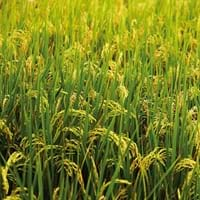Origin
South America, Micronesia, New Zealand
Eastern Africa, Northern Africa, Southern Asia, Southeastern Asia
Types
Not Available
Akia Beruin Red, Ofada Rice, Topaz
Number of Varieties
Not Available
Habitat
coastal environs, Grassland, Roadsides, Waste areas, waterways
Muddy habitat
USDA Hardiness Zone
7-11
8-15
AHS Heat Zone
11 - 7
12 - 1
Sunset Zone
H1, 3a, 3b, 4, 5, 6, 7, 8, 9, 10, 11, 12, 13, 14, 15, 16, 17, 18, 19, 20, 21, 22, 23, 24
Not Available
Habit
Clump-Forming
Clump-Forming
Minimum Height
Not Available
Minimum Width
Not Available
Flower Color
Purple
White
Flower Color Modifier
Bicolor
Bicolor
Fruit Color
Not Available
White
Leaf Color in Spring
Green, Light Green, Dark Green
Green
Leaf Color in Summer
Light Green
Light Green
Leaf Color in Fall
Green, Light Green, Dark Green
Green
Leaf Color in Winter
Dark Green, Tan
Not Available
Leaf Shape
Grass like
Grass like
Plant Season
Spring, Summer, Fall, Winter
Summer, Fall
Sunlight
Full Sun
Full Sun
Growth Rate
Fast
Very Fast
Type of Soil
Loam
Clay, Loam
The pH of Soil
Acidic, Neutral
Acidic, Neutral, Alkaline
Soil Drainage
Well drained
Average
Bloom Time
Summer, Fall
Not Available
Tolerances
Drought, Salt
Wet Site, Salt
Where to Plant?
Ground
Ground
How to Plant?
Seedlings
Seedlings, Transplanting
Plant Maintenance
Medium
Medium
Watering Requirements
Average Water Needs
Keep plant submerged in water
In Summer
Lots of watering
Ample Water
In Spring
Moderate
Lots of watering
In Winter
Average Water
Consistently
Soil pH
Acidic, Neutral
Acidic, Neutral, Alkaline
Soil Type
Loam
Clay, Loam
Soil Drainage Capacity
Well drained
Average
Sun Exposure
Full Sun
Full Sun
Pruning
Remove damaged leaves, Remove dead branches, Remove dead leaves
No need to prune
Fertilizers
All-Purpose Liquid Fertilizer
Fertilize the soil before planting, Phosphorous, Potassium
Pests and Diseases
Red blotch
Bacteria, Birds, fungus, Nematodes, Rats, Snails, Viruses
Plant Tolerance
Drought
Salt, Wet Site
Flowers
Showy
Insignificant
Flower Petal Number
Single
Single
Foliage Texture
Fine
Medium
Foliage Sheen
Matte
Matte
Attracts
Not Available
Birds
Allergy
Itchiness
Not Available
Aesthetic Uses
Showy Purposes
Not Used For Aesthetic Purpose
Beauty Benefits
Not Available
Good for skin
Edible Uses
Sometimes
Yes
Environmental Uses
Air purification
Air purification, Prevent Soil Erosion
Medicinal Uses
Not Available
Energy, High blood pressure, Skin Disorders, Swelling
Part of Plant Used
Flowers, Leaves
Seeds
Other Uses
Animal Feed, Used as Ornamental plant
Starch, Used as a nutritious food item, Used As Food
Used As Indoor Plant
No
No
Used As Outdoor Plant
Yes
Yes
Garden Design
Cutflower, Dried Flower/Everlasting, Feature Plant, Foundation, Groundcover, Mixed Border, Screening / Wind Break
Container, Dried Flower/Everlasting, Edible, Herb / Vegetable, Houseplant, Tropical, Water Gardens
Botanical Name
CORTADERIA jubata
ORYZA
Common Name
Purple Pampas Grass
Rice
In Hindi
Purple pampas grass
चावल
In German
Lila Pampasgras
Reis
In French
Pourpre herbe de pampa
riz
In Spanish
hierba púrpura pampas
arroz
In Greek
Μωβ γρασίδι παμπάς
ρύζι
In Portuguese
grama roxa pampas
arroz
In Polish
Purpurowy trawa pampasów
ryż
In Latin
Purpura Pampas herba
rice
Phylum
Magnoliophyta
Magnoliophyta
Class
Liliopsida
Liliopsida
Clade
Angiosperms, Commelinids, Monocots
Not Available
Tribe
Not Available
Not Available
Subfamily
Not Available
Not Available
Number of Species
Not Available
Not Available
Importance of Purple Pampas Grass and Rice Plant
Want to have the most appropriate plant for your garden? You might want to know the importance of Purple Pampas Grass and Rice Plant. Basically, these two plants vary in many aspects. Compare Purple Pampas Grass and Rice Plant as they differ in many characteristics such as their life, care, benefits, facts, etc. Every gardener must at least have the slightest clue about the plants he wants to plant in his garden. Compare their benefits, which differ in many ways like facts and uses. The medicinal use of Purple Pampas Grass is Not Available whereas of Rice Plant is Energy, High blood pressure, Skin Disorders and Swelling. Purple Pampas Grass has beauty benefits as follows: Not Available while Rice Plant has beauty benefits as follows: Not Available.
Compare Facts of Purple Pampas Grass vs Rice Plant
How to choose the best garden plant for your garden depending upon its facts? Here garden plant comparison will help you to solve this query. Compare the facts of Purple Pampas Grass vs Rice Plant and know which one to choose. As garden plants have benefits and other uses, allergy is also a major drawback of plants for some people. Allergic reactions of Purple Pampas Grass are Itchiness whereas of Rice Plant have Not Available respectively. Having a fruit bearing plant in your garden can be a plus point of your garden. Purple Pampas Grass has showy fruits and Rice Plant has no showy fruits. Also Purple Pampas Grass is not flowering and Rice Plant is not flowering . You can compare Purple Pampas Grass and Rice Plant facts and facts of other plants too.





